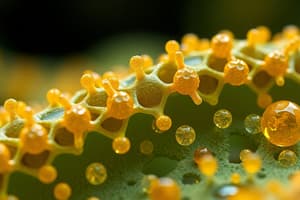Podcast
Questions and Answers
What significant event took place in December 1959 at the California Institute of Technology?
What significant event took place in December 1959 at the California Institute of Technology?
- The discovery of nano-crystals in toothpaste
- The first use of the term nanotechnology
- The development of gold nanoparticles for cancer detection
- Richard Feynman delivered a lecture about controlling atoms (correct)
Who first used the term 'nanotechnology' after Feynman's lecture?
Who first used the term 'nanotechnology' after Feynman's lecture?
- Albert Einstein
- Richard Feynman
- Norio Taniguchi (correct)
- Drexler
What size range is associated with nanotechnology as described by Feynman?
What size range is associated with nanotechnology as described by Feynman?
- 10^-9 meters (correct)
- 10^-12 meters
- 10^-6 meters
- 10^-10 meters
What is the Greek origin of the term 'nano'?
What is the Greek origin of the term 'nano'?
Which of the following applications of nanotechnology was mentioned?
Which of the following applications of nanotechnology was mentioned?
What revolution did Richard Feynman's ideas contribute to?
What revolution did Richard Feynman's ideas contribute to?
After Feynman's lecture, what was Norio Taniguchi's contribution to the field?
After Feynman's lecture, what was Norio Taniguchi's contribution to the field?
Which of the following is not a proposed future use of nanotechnology mentioned?
Which of the following is not a proposed future use of nanotechnology mentioned?
What is the definition of nanotechnology according to the National Nanotechnology Initiative?
What is the definition of nanotechnology according to the National Nanotechnology Initiative?
How many nanometers are there in one inch?
How many nanometers are there in one inch?
If a marble were the size of one nanometer, what would one meter be compared to?
If a marble were the size of one nanometer, what would one meter be compared to?
Which equipment was critical for the advancement of nanotechnology?
Which equipment was critical for the advancement of nanotechnology?
What historical application of nanoscale materials is mentioned?
What historical application of nanoscale materials is mentioned?
What did scientists in the past lack that hindered their ability to manipulate atoms?
What did scientists in the past lack that hindered their ability to manipulate atoms?
What happens when one dimension of a material is less than 1 nanometer?
What happens when one dimension of a material is less than 1 nanometer?
What did artisans use to achieve color changes in stained glass windows?
What did artisans use to achieve color changes in stained glass windows?
Flashcards are hidden until you start studying
Study Notes
Introduction and History of Nanobiotechnology
-
The foundation of nanotechnology was laid in December 1959 when Richard Feynman delivered a lecture titled "There's Plenty of Room at the Bottom" at the California Institute of Technology.
-
Feynman's lecture addressed the manipulation of atoms and molecules at a scale of 10^-9 meters, now known as the nanoscale.
-
The term "nanotechnology" was coined by Norio Taniguchi in 1974 to describe the precision machining of materials at the nanoscale.
-
The National Nanotechnology Initiative defines nanotechnology as the "manipulation of matter with at least one dimension sized between 1 to 100 nanometers".
-
One nanometer is equivalent to 1/25,400,000 of an inch.
-
To visualize this scale, if a marble represented one nanometer, then one meter would be the size of the Earth.
-
The discovery of the Scanning Tunneling Microscope (STM) and the Atomic Force Microscope (AFM) in the late 20th century revolutionized the advancement of nanotechnology by enabling scientists to observe and manipulate atoms.
-
Despite the relatively recent rise of nanoscience as a field of study, nanoscale materials have been used for centuries.
-
The stained glass windows of medieval churches demonstrate the use of nanoscale materials, where artists utilized silver and gold particles of varying sizes to achieve specific colors and effects.
Studying That Suits You
Use AI to generate personalized quizzes and flashcards to suit your learning preferences.




